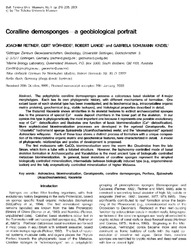Coralline demosponges ; a geobiological portrait
Journal: Bulletin / The Tohoku University Museum, 2001, 1: 219 - 235
Reitner, Joachim; Wörheide, Gert; Lange, Robert; Schumann-Kindel, Gabriela, 2001: Coralline demosponges ; a geobiological portrait. In: Reitner, Joachim; Wörheide, Gert; Lange, Robert; Schumann-Kindel, Gabriela (2001): Coralline demosponges ; a geobiological portrait - Bulletin / The Tohoku University Museum; Nr. 1, p. 219-235, DOI: 10.23689/fidgeo-2565.
 |
View/
|
The polyphyletic coralline demosponges possess a calcareous basal skeleton of 4 major
morphotypes. Each has its own phylogenetic history, with different mechanisms of formation. One
extant taxon of each skeletal type has been investigated, and its biochemical (e.g., intracrystalline organic
matrix proteins), geochemical (e.g., stable isotopes), and histological properties described in detail.
The thalamid Vaceletia shows similarities in its skeletal features to extinct archaeocyathid sponges
due to the presence of special Ca2+ waste deposit chambers in the lower part of the skeleton. In our
opinion this type is phylogenetically the most important one because it represents one possible evolutionary
way of Ca2+ detoxification and iIIustrates one function of basic biomineralization (Ca2+-detoxification).
More sophisticated biomineralization processes are developed in the agelasid Ceratoporella, the
"chaetetid" hadromerid sponge Spirastrella (Acanthochaetetes) weil si, and the "stromatoporoid" agelasid
Astrosclera willeyana. Each of these taxa shows a distinct process of formation with a unique composition
of its intracrystalline organic matrix and geochemical features, here characterized in detail. A model
of phylogenetic relationships and grades of development is proposed.
The first metazoans with CaC03 biomineralization were the worm- like Cloudinidae from the late
Sinian, which form a tube with a foliated structure. However, the taphonomy- controlled mode of basal
skeleton formation in Archaeocyatha and Vaceletidae is the most ancient type of biologically- controlled
metazoan biomineralization. In general, basal skeletons of coralline sponges represent the simplest
biologically controlled mineralization, intermediate between biologically induced type (e.g., organomineralization)
and the fully enzymatically- controlled mineralization of higher Metazoa.

